Posted: February 20th, 2007 | 1 Comment »
My paper (co-authored with Mike Blackstock and Nicolas Nova) for the workshop on Common Models and Patterns for Pervasive Computing (CMPPC) at the Pervasive 2007 conference has been accepted. All the accepted position papers are available online.
Issues from Deploying and Maintaining a Pervasive Game on Multiple Sites (pdf)
Abstract. In this paper we present the lessons learned from the deployment of a collaborative pervasive game on two different sites. We emphasize on the practical aspects of getting a pervasive systems deployed without any extra special infrastructure. Based on our experience, we describe the issues providers and administrators must take into consideration to deploy and maintain pervasive environments. In this perspective, we highlight that ubiquitous technologies must be consciously attended, as they are unevenly distributed, unevenly available.
Relation to my thesis: a paper I can link to whenever I mention the issues around deploying and maintaining CatchBob! Pervasive 2007 will take place on May 13-16 in Toronto, Ontario, Canada.
Posted: February 20th, 2007 | 1 Comment »
My paper for the CHI 2007 doctoral consortium has been accepted.
Bridging the social-technical gap in location-aware computing
Abstract. Building ubiquitous applications that exploit location requires integrating underlying infrastructure for linking sensors with high-level representation of the measure space to support human activities. However, the real-world constraints limit the efficiency of location technologies. The inherent spatial uncertainty embedded in mobile and location systems constantly challenges the coexistence of digital and physical spaces. Consequently, the technical mechanisms fail to match the highly flexible, nuanced, and contextual human spatial activities. These discrepancies generate a social-technical gap between what should be socially supported and what can be technically achieved. My research aims at exploring, and hopefully reducing this gap in the context of location-aware computing.
Relation to my thesis: “In total, we received 96 submissions and 15 were accepted to participate at the conference”. This is a clear sign that the definition and expression of my ideas have matured. CHI 2007 will take place in San Jose, CA between April 28 and May 3.
Posted: February 18th, 2007 | No Comments »
Davies, N., Landay, J., Hudson, S., and Schmidt, A. Guest editors’ introduction: Rapid prototyping for ubiquitous computing. Pervasive Computing, IEEE 4, 4 (Oct.-Dec. 2005), 15– 17.
The authors suggest that, as in earlier HCI efforts, the progress in prototyping methods and tools is central overcome the barriers to widespread development and deployment of ubicomp. Rapid prototyping techniques can partially solve the current dilemma of researchers and developers who must concentrate on their specific area to advance technology rather than expend effort on broad system-implementation issues. Low-fidelity prototyping can adapt to the pervasive computing requirements and proves to be an essential means to address the questions about user performance and user acceptance.
This paper serves as introduction to Prototypes in the Wild: Lessons from Three Ubicomp Systems.
Relation to my thesis: A useful ref for my “in sitiu” approach of location-aware system evaluation. Actually, the authors describe it as:
Research shows that prototyping and deploying systems for study is important to understanding how systems fit into the user’s world and how they can be used effectively. Designing, building, and deploying systems help both researchers and developers better understand a particular application domain’s key issues. This issue provides a rich body of experience in issues associated with prototype deployment.
Posted: February 17th, 2007 | No Comments »
I got mostly aware of persuasive computing during last year’s ubicomp conference, and Yvonne Rodger’s paper Moving on from Weiser’s Vision of Calm Computing: Engaging UbiComp Experiences. Persuasive computing, in reaction to calm computing, aims at using technologies that motivate, facilitate and trigger changes in behavior and attitudes. The trend I believe mainly comes from the US due to the country’s weight and health problems.
One example is Julian Bleecker’s Flavonoid that transact actions and activities between the physical worlds and digital online worlds. Flavonoid is envisioned as a platform for a variety of embodiments. In one embodiment of the project concept, data feeds produced from the Flavonoid Kinesthometer is used to “bulk up” or “fatten up” its owner digital photograph on a social networking site, depending on whether he/she has been actively moving or sedentary in 1st Life. In another embodiment of the project concept, data feeds from the Flavonoid Kinesthometer slows one’s online character down in 2nd Life for lack of energy based on sedentary 1st Life behavior.
Early this month, the Stanford Persuasive Technology Lab (BJ Fogg, Dean Eackles) hosted the Mobile Persuasion 2007 conference. Joe McCarthy posted a summarized version of his 12 pages notes: Mobile Persuasion 2007: Triggering Changes in Attitudes and Behavior. From what I can read, the main use of technology to change people’s beliefs and behaviors are to: make the invisible visible, raise awareness of [bad] habits in communication, transportation (environmental issue), exercise (activity-induced energy expenditure (AEE) over the body mass index (BMI)) and diet, (persuasive) gaming.
Prior to CHI, the Stanford Persuasive Technology Lab will be hosting the Persuasive 07 conference.
Relation to my thesis: Same as for an calm vision of ubicomp, technology cannot persuade anyone who doesn’t already want to be want to be persuaded. The frontier between engagement and persuasiveness is still unclear to me. My recent posts on the new agendas of ubicomp can strengthen the introduction in my thesis.
Posted: February 16th, 2007 | No Comments »
At the end of his talk on Big Games: Large-Scale, Multi-Player, Real-World Games at Where 2.0 in 2005 (audio), Kevin Slavin came up some “chili computing” (coined by Frédéric Kaplan at Lift) concepts around the experience of location in real-world games. First he mentioned that location is more than GIS data. Location has a wider context and different meanings, it is about being indoors, outdoors, about hearing the busy sound of a street or not. Then he suggest that in fact disinformation and “dislocation” might be more engaging to people as we might become interested into getting lost and making things up (aiming at misrepresentation rather than accuracy). This idea of inventing the real reminds me a discussion with Julian on his current game ideas around the concept of familiar strangers and his inspiring talk When 1st Life Meets 2nd Life.
Relation to my thesis: While my specific work aims at the opposite of using technologies to get lost and tell use lies, I find the approach very relevant. The approach actually reveals that “constraints aren’t what break games. Constraints are what makes them work”. It can be an inspiration for designer of location-aware systems who must deal with quality and accuracy issues could. Instead of hiding the problems or aiming at sharp accuracy, an application might be more engaging when it is less “serious”. This relates to my last week’s discussionwith Frédéric on the nabaztag who tells the weather. Because, the nabaztag is not serious by itself, it is okay if he makes mistakes on forecasting the weather. Actually, its mistakes might lead into a discussion and a collaborative correction of the error.
Posted: February 16th, 2007 | No Comments »
Skyhook Wireless announced at 3GSM the collaboration with SiRF to create a single positioning system that combines the best of both GPS and Wi-Fi technologies. I could also get a glimpse in the upcoming Skyhook-enabled iRiver W10.
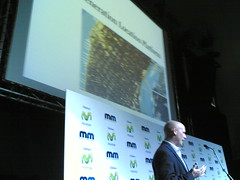
Jed Rice, Skyhook Wireless, at the Mobile Monday Global Peer Awards.
Relation to my thesis: Location sensor fusion is now happening in the industry. In the context of my research, the limitation of this approach is still at a network level to communicate the sensed position. While WiFi access points can be used for triangulation, an open access cannot be legally used to exchange data. In consequence, collaborative (and synchronous) location-aware application must uniquely rely on GSM.
At the Mobile Monday Global Peer Awards, Jed Rice announced that Skyhook had “scanned” Barcelona over the last past weeks. This is certainly an opportunities to play around with their APIs and prototype my upcoming experiments. Skyhook nurtures tight relations with the academic world and have been involved in facilitating pervasive and big games in partnership with Kevin Slavin and Frank Lantz’s company area/code. The same Keven Slavin who teaches urban computing at NYU with Adam Greenfield. Small world.
I love the happy contradictions of 3GSM. Ironically, once again this year, it was almost impossible to get decent WiFi connexion. I was also presented a path description to a restaurant drawn on by an LBS specialist on the back of his business card:
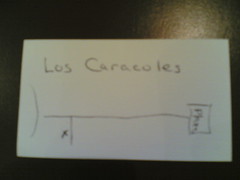
Posted: February 15th, 2007 | 1 Comment »
Last week, I participated to a workshop on The City of the Future organized by Nicolas Nova (EPFL) and William Cockayne (Stanford). More than brainstorming about, it was the opportunity to learn about critical foresight methodology and techniques. Both Mauro and Nicolas wrote a very complete report on the petal graph, the S-curve, cartesian diagram and the diachronic table.
Relation to my thesis: ubicomp is also about projecting how sensor, wireless and distributed technologies will be used and integrated in the future. In foresight much can be learned by looking at the past and comparing it with the present. Now that we have the first glimpse of real-world ubicomp environments (as mentioned by Adam Greefield, Bell and Dourish) we can reflect on Mark Weiser’s visions of calm computing and the dissapearing computer. Based on how we got here, we can start building alternative agendas such as the new approaches suggested by Yvonne Rodgers. During the workshop we watched Walt Disney’s visions for the city of EPCOT in the 60s to reflect on our own visions of the future of the city (e.g. where was Walt wrong or correct and what path lead to his visions).
Posted: February 14th, 2007 | No Comments »
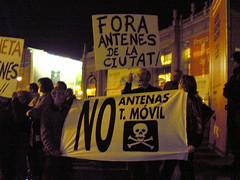
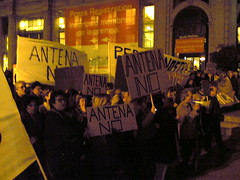
A protest in front of the 3GSM Congress in Barcelona last night. I like the “Keep the antennas out of the city!” not-in-my-backyard kind of sign as well as, on the side, a placard referring to the bible.
Reuters (blog) reports:
Demonstrators in Barcelona rallied against cell towers and radiation outside the fenced-off 3GSM, the world’s largest wireless trade show. About 100 protesters carried placards and chanted: “Don’t just talk business, talk about health as well.” Where are the tin-foil hats when you need them?
Relation to my thesis: constraints to innovation and “progress”.
Posted: February 11th, 2007 | 13 Comments »
On Friday, I gave a talk on Embracing the Real World’s Messiness (slides, video) at the Lift Conference open stage session. Some people in the audience took notes and pictures, including Tom Hume (Future Platforms), Hubert Guillaud (Fing, en français) and Mark Meagher (EPFL).
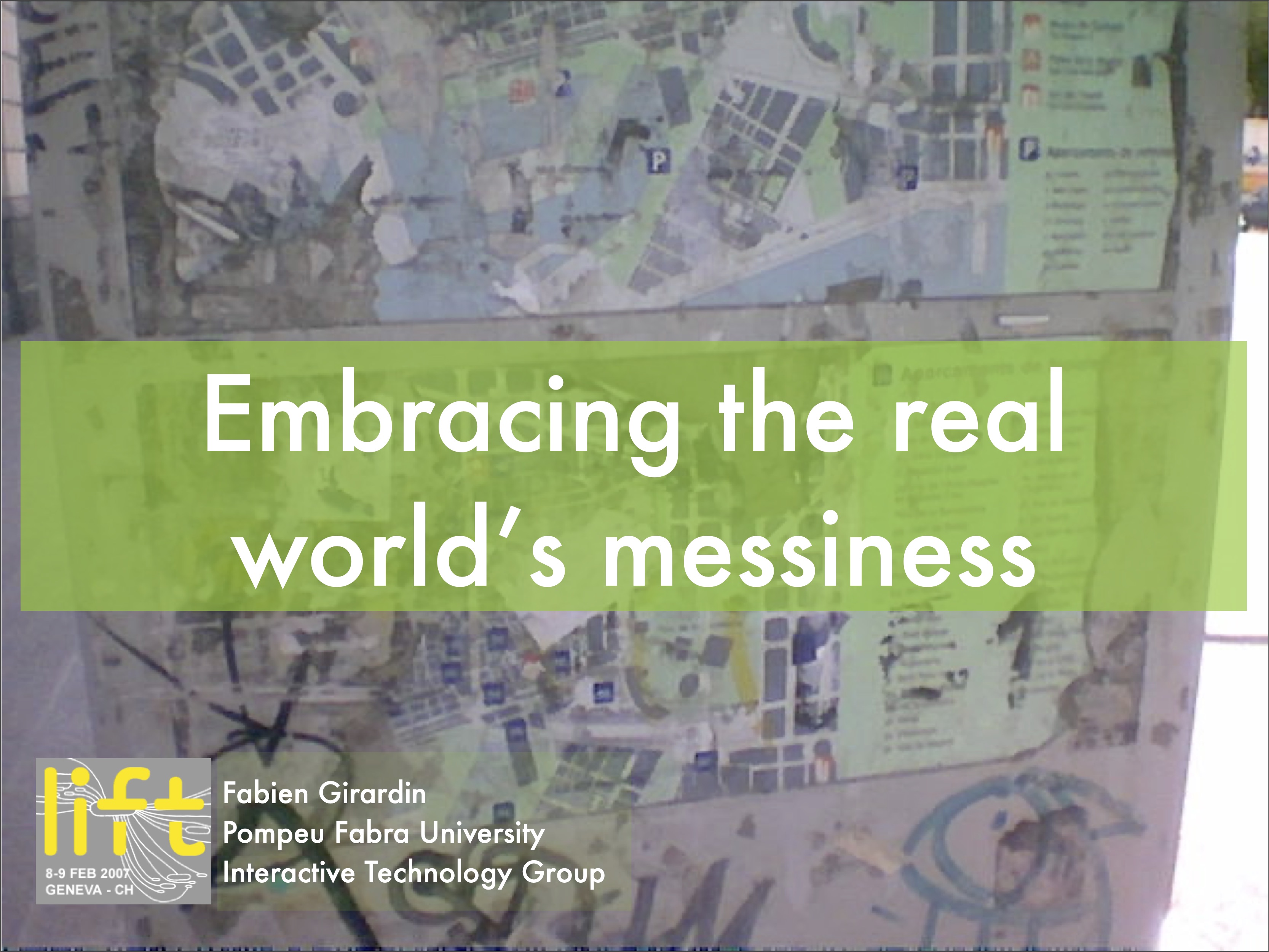
Relation to my thesis: While I did not present the core of my research, the topic can serve as introduction to my thesis.
I felt a research or engineering talk would not have completely fit to the audience. Therefore, I rather preferred taking the role of the observer of the current integration of sensor technologies in our everyday life in order to question the seamlessness and calmness visions in ubiquitous computing. Even though I feel I only communicated 1/3 of my thoughts, the feedback I received suggest that I delivered my message. In his wrap-up talk (video), Daniel Kaplan shared my observations in highlighting that “we’re using technology to create disorder – you can call it innovation, I call it disorder”. I have been enjoying reading Daniel since he coined the term “Désordinateurs” in reaction from the “Utopie du lisse“.
This talk was based on a few previous blog post, including:
Posted: February 6th, 2007 | No Comments »
Rogers, Y. Moving on from weiser’s vision of calm computing: Engaging ubicomp experiences. In Ubicomp (2006), pp. 404–421.
This paper urges for an alternative agenda in ubicomp research that shifts from Weiser’s calm vision to engaging people (i.e. proactive computing, persuasive computing, engaged living). Yvonne Rogers acknowledges that research in context awareness, ambient intelligence and monitoring/tracking have been somehow fruitful. However they have yet failed to reach Weiser’s world. Indeed, there is an enormous gap between the dream of conformable, informed and effortless living and the accomplishment of UbiComp research. In fact, the fundamental stumbling block has been harnessing the huge variability in what people do, their motives for doing it, when they do it and how they do it. While it has been possible to develop a range of simple ubicomp systems that can offer relevant information at opportune moment, it is proving to be much more difficult to build truly smart systems that can understand or accurately model people’s behaviors, moods and intentions. This makes it difficult, if not impossible, to try to implement context in any practical sense and from which to make sensible predictions about what someone is feeling, wanting or needing at a given moment. Therefore, ubicomp technologies should be designed not to do things for people but to engage them more actively in what they currently do. Rather than calm living it promotes engaged living, where technology is designed to enable people to do what they want, need or never even considered before by acting in and upon the environment. Examples include extending and supporting personal, cognitive and social processes such as habit-changing, problem solving, creating, analyzing, learning or performing a skill.
The author mentions the problems of calm computing in the most prominent ubicomp research themes (i.e. context-aware computing, ambient/ubiquitous intelligence and recording/tracking and monitoring).
Context-awareness
Key questions in context-aware computing concern what to sense, what form and what kind of information to represent to augment ongoing activities. Many of the sensor technologies, however, have been beset with detection and precision limitations, sometimes resulting in unreliable and inaccurate data. While newer technological developments may enable more accurate data to be detected and collected it. However, people often behave in unpredictable and subtle ways in their day-to-day contexts. Therefore, it is likely that context-aware systems will only ever be successful in highly constrained settings.
Ambient and Ubiquitous Intelligence
While there have been significant advances in computer vision, speech recognition and gesture-based detection, the reality of multimodal interfaces – that can predict and deliver with accuracy and sensitivity what is assumed people want or need – is a long way off. In consequence, when a ubiquitous computing system gets it wrong – which is likely to be considerably more frequent – it is likely to be more frustrating and we are likely to be less forgiving.
Recording, Tracking and Monitoring
Much of the discussion about the human aspects in ubicomp has been primarily about the trade-offs between security and privacy, convenience and privacy, and informedness and privacy. This focus has often been at the expense of other human concerns receiving less airing, such as how recording, tracking and re-representing movements and other information can be used to facilitate social and cognitive processes.
Yvonne mentions 2 goals of my research, one being to use ubicomp technologies in the wild, the other to evaluate how to present data and information:
In addition, more studies are needed of UbiComp technologies being used in situ or the wild – to help illuminate how people can construct, appropriate and use them. With respect to interaction design issues, we need to consider how to represent and present data and information that will enable people to more extensively compute, analyze, integrate, inquire and make decisions; how to design appropriate kinds of interfaces and interaction styles for combinations of devices, displays and tools; and how to provide transparent systems that people can understand sufficiently to know how to control and interact with them.
Currently, the more engaging approach is beginning to happen through the areas of playful and learning practices, scientific practices and persuasive practices.
As already mentioned in Comparing AI’s Failures with Ubicomp’s Visions, Yvonne Rogers concludes on “strong” and “weak” UbiComp.
Just as ‘strong’ AI failed to achieve its goals – where it was assumed that “the computer is not merely a tool in the study of the mind; rather, the appropriately programmed computer really is a mind”, it appears that ‘strong’ UbiComp is suffering from the same fate. And just as ‘weak’ AI2 revived AI’s fortunes, so, too, can ‘weak’ UbiComp bring success to the field.
Relation to my thesis: I would argue that current “strong” UbiComp problems not only lays on modelling people and their activities, but also in the integration ubicomp systems in the real-world (e.g. co-existence of systems, real-world constraints). I enjoy the difference between what is “relevant” and what is “smart”, as I find the word smart or intelligent are widely (over)misused. Finally, the agenda proposed in this article, goes in the direction of my research: in sitiu (out of the lab) studies, investigate the playful approach of ubicomp and how to present relevant information rather than seeking the seamlessness utopia.






